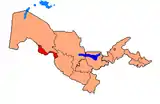Khorazm Region
Khorazm Region (Uzbek: Xorazm viloyati, Хоразм вилояти, خارەزم ۋىلايەتى, is a viloyat (region) of Uzbekistan located in the northwest of the country in the lower reaches of the Amu Darya River. It borders with Turkmenistan, Karakalpakstan, and Bukhara Region. It covers an area of 6,050 square kilometres (2,340 sq mi).[1] The population is estimated 1,893,300 (2021), with 67% living in rural areas.[2] The capital is Urgench (pop. est. 145,000). Other major towns include Xonqa, Khiva, Shovot, and Pitnak.

Khorazm Region
Xorazm viloyati, Хоразм вилояти | |
|---|---|
.jpg.webp) | |
 Khorazm in Uzbekistan | |
| Coordinates: 41°20′N 61°0′E | |
| Country | Uzbekistan |
| Established | 1938 |
| Capital | Urgench |
| Government | |
| • Hokim | Farhod Ermanov |
| Area | |
| • Total | 6,050 km2 (2,340 sq mi) |
| Elevation | 98 m (322 ft) |
| Population (2021) | |
| • Total | 1,893,300 |
| • Density | 310/km2 (810/sq mi) |
| Time zone | UTC+5 (East) |
| ISO 3166 code | UZ-XO |
| Districts | 11 |
| Cities | 3 |
| Towns | 56 |
| Villages | 550 |
| Website | www |
The climate is a typically arid continental climate, with cold winters and extremely hot, dry summers.
The city of Khiva in Khorezm Region is a UNESCO World Heritage Site with world-famous architectural monuments, making Khiva one of the main centers for international tourism in the country.
The economy of Khorezm Region is primarily based on cotton. Cotton is by far the main crop, although rice production has increased significantly in the last several years. (though the Uzbek government discourages rice production near to deserts, over water usage concerns) There are also many orchards and vineyards, melon and gourd plantations and potato fields. Khorezm Region is famous for its "gurvak" melon in Uzbekistan. Industry is also heavily oriented to cotton, with cotton refining, cottonseed oil extraction and textiles predominating. Khorezm is a place where many famous scholars were born, such as Abu Rayhan Biruni and al-Khwārizmī. The region has a well-developed transportation infrastructure, with over 130 km of railways and 2000 km of surfaced roads. The region is connected by rail to European Russia and the Caucasus.
Administrative divisions

The Xorazm Region consists of 11 districts (listed below) and two district-level cities: Urgench and Khiva.[1][3]
There are 3 cities (Urgench, Khiva, Pitnak) and 56 urban-type settlements in the Xorazm Region.[1][3] In March 2020 the new Tuproqqalʼa District was created out of the larger, eastern part of Hazorasp District.[4] Gurlen is one of the most unique districts in the region.
See also
References
- "Oʻzbekiston Respublikasining maʼmuriy-hududiy boʻlinishi" [Administrative-territorial division of the Republic of Uzbekistan] (in Uzbek). The State Committee of the Republic of Uzbekistan on statistics. July 2021. Archived from the original on 4 February 2022.
- "Viloyat bo'yicha shahar va qishloq aholisi soni" [Urban and rural population in the region] (PDF) (in Uzbek). Xorazm regional department of statistics.
- "Classification system of territorial units of the Republic of Uzbekistan" (in Uzbek and Russian). The State Committee of the Republic of Uzbekistan on statistics. July 2020.
- Decree 23 March 2020, 184-IV, LexUZ.

